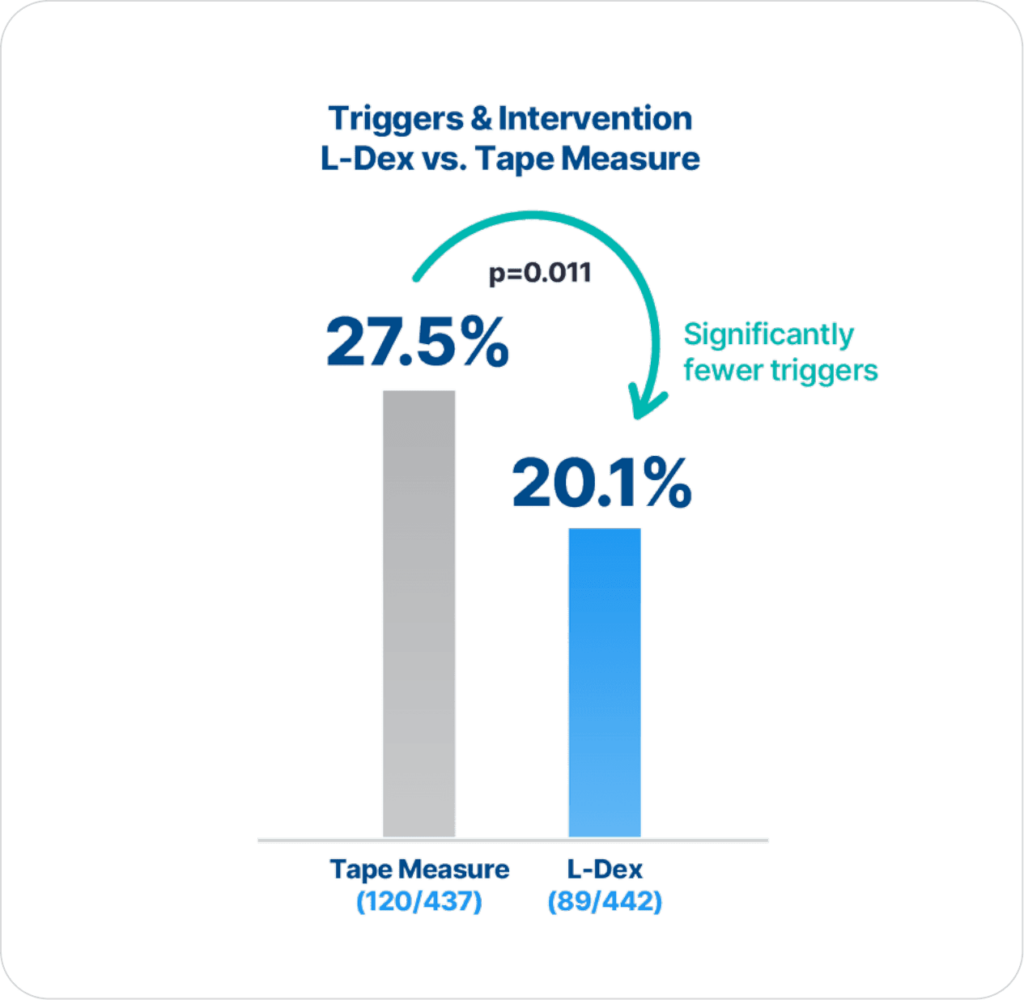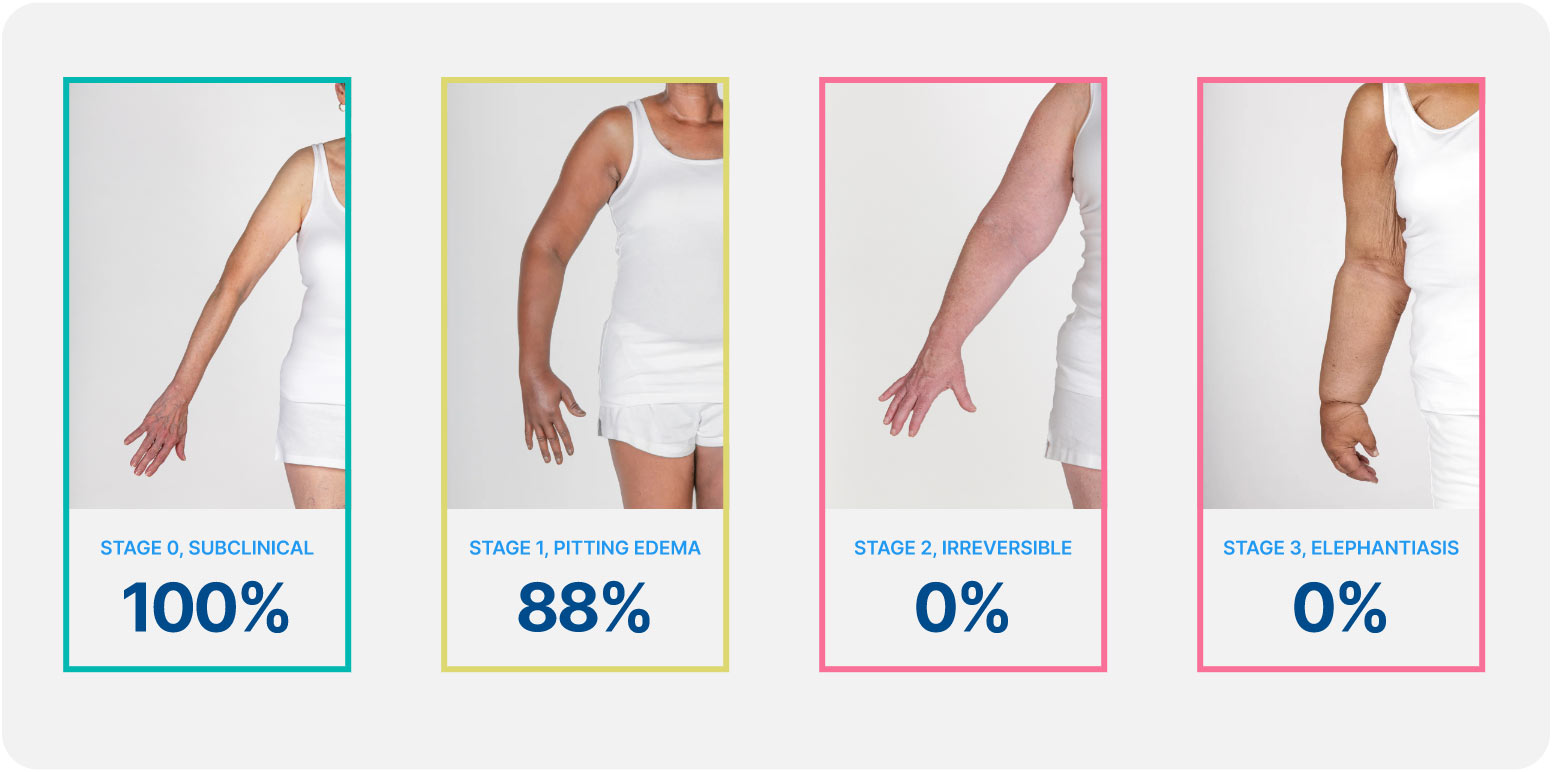
ImpediMed’s BIS technology is more precise and reliable than tape measure in detecting lymphedema (LE), as there are statistically significantly fewer triggers and interventions for those assessed with BIS compared to tape measure (p=0.011)2.
Extensive clinical evidence shows that using ImpediMed’s bioimpedance spectroscopy (BIS) technology for early detection and intervention reduces the impact of chronic lymphedema on breast cancer patients.
Lymphedema develops in stages, and a university of Kansas study found that when lymphedema is detected at stage 0 or stage 1 it is reversible, but in stages 2 and 3 it is not. These findings demonstrate how early conservative intervention and prospective monitoring with BIS can significantly lower rates of BCRL and persistent BCRL (pBCRL).¹

The PREVENT Trial involved 10 centers across the US and Australia and was the largest randomized controlled trial (RCT) to assess lymphedema prevention in breast cancer patients.
In summary, prospective surveillance of breast cancer patients (most of whom were considered high risk) for the development of BCRL using BIS permitted the detection and simple pre-emptive management of subclinical disease resulting in a very low rate of chronic lymphedema compared to the established, expected range. These findings (which represent the largest group of patients monitored in a structured, program for early detection of BCRL using BIS) support the cost-effective allocation of resources for prospective, BIS assisted, BCRL surveillance within guidelines-based breast cancer survivorship programs. For women at risk for BCRL, this protocol represents a useful option to meet NCCN guidelines for the education, monitoring and treatment of BCRL.
Whitworth, P.W. and A. Cooper, Reducing chronic breast cancer-related lymphedema utilizing a program of prospective surveillance with bioimpedance spectroscopy. Breast J, 2018. 24(1): p. 62-65.
The results of this retrospective study demonstrate that L-Dex assessments can be incorporated into routine breast cancer programs as part of follow-up. This is critically important given the recent changes in the NCCN survivorship guidelines for post-treatment follow-up care for breast cancer patients establishing that health-care providers “educate, monitor, and refer for lymphedema management.” Additionally, the analyses suggest that L-Dex assessments can identify subclinical BCRL and subsequently monitor the return to baseline following conservative interventions. Further studies are required to demonstrate the long-term benefits of early detection and subsequently early intervention predicated upon subclinical detection of BCRL.
Laidley, M., Alison and M. Anglin, Beth, The Impact of L-Dex® Measurements in Assessing Breast Cancer Related Lymphedema (BCRL) as Part of Routine Clinical Practice. Frontiers in Oncology, 2016. 6(192).
To our knowledge, this is the first prospective study of patients who underwent ALND for breast cancer in which BIS technology was used to detect LE and evaluate the benefits of early diagnosis and treatment interventions objectively. We demonstrated that periodic monitoring of women at high risk for LE, with BIS technology, allowed detection of subclinical LE and timely intervention for treatment, resulting in a reduction of clinical LE from 36.4% to 4.4%. Future studies will determine whether this translates into reduced total health care costs and improved quality of life for patients with breast cancer.
Soran, A., et al., The importance of detection of subclinical lymphedema for the prevention of breast cancer-related clinical lymphedema after axillary lymph node dissection; a prospective observational study. Lymphat Res Biol, 2014. 12(4): p. 289-94